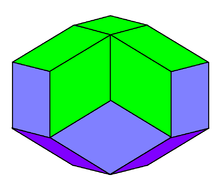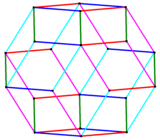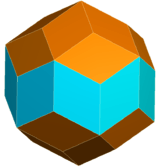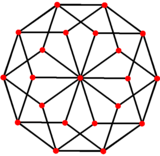Rhombic icosahedron
| Rhombic icosahedron | |
|---|---|
 | |
| Type | Zonohedron |
| Faces | 20 rhombi |
| Edges | 40 |
| Vertices | 22 |
| Faces per vertex | 3, 4 and 5 |
| Dual polyhedron | Irregular-faced pentagonal gyrobicupola |
| Symmetry | D5d, [2+,10], (2*5) |
| Properties | convex, zonohedron |
A rhombic icosahedron is a polyhedron shaped like an oblate sphere. It is composed of 20 rhombic faces, of which three, four, or five meet at each vertex. It has 10 faces on the axis of symmetry with 10 rhombi following the equator. It has D5d, [2+,10], (2*5) symmetry, order 20.
Even though all the faces are congruent, the rhombic icosahedron is not face-transitive, since one may distinguish whether a particular face is near the equator or a pole by examining the types of vertices surrounding that face.
Zonohedron
The rhombic icosahedron is a zonohedron that is dual to an irregular-faced pentagonal gyrobicupola. It has 5 sets of 8 parallel edges, described as 85 belts.
 |
The edges of the rhombic icosahedron exist in 5 parallel sets, seen in this wireframe orthogonal projection. |
The rhombic icosahedron forms the convex hull of the vertex-first projection of a 5-cube to 3 dimensions. The 32 vertices of a 5-cube map into 22 exterior vertices of the rhombic icosahedron, with the remaining 10 interior vertices forming a pentagonal antiprism. This is the same way one can obtain a Bilinski dodecahedron from a 4-cube and a rhombic triacontahedron from a 6-cube.
Related polyhedra
The rhombic icosahedron can be derived from the rhombic triacontahedron by removing 10 middle faces.
 A rhombic triacontahedron as an elongated rhombic icosahedron |
 The rhombic icosahedron shares its 5-fold symmetry orthogonal projection with the rhombic triacontahedron |